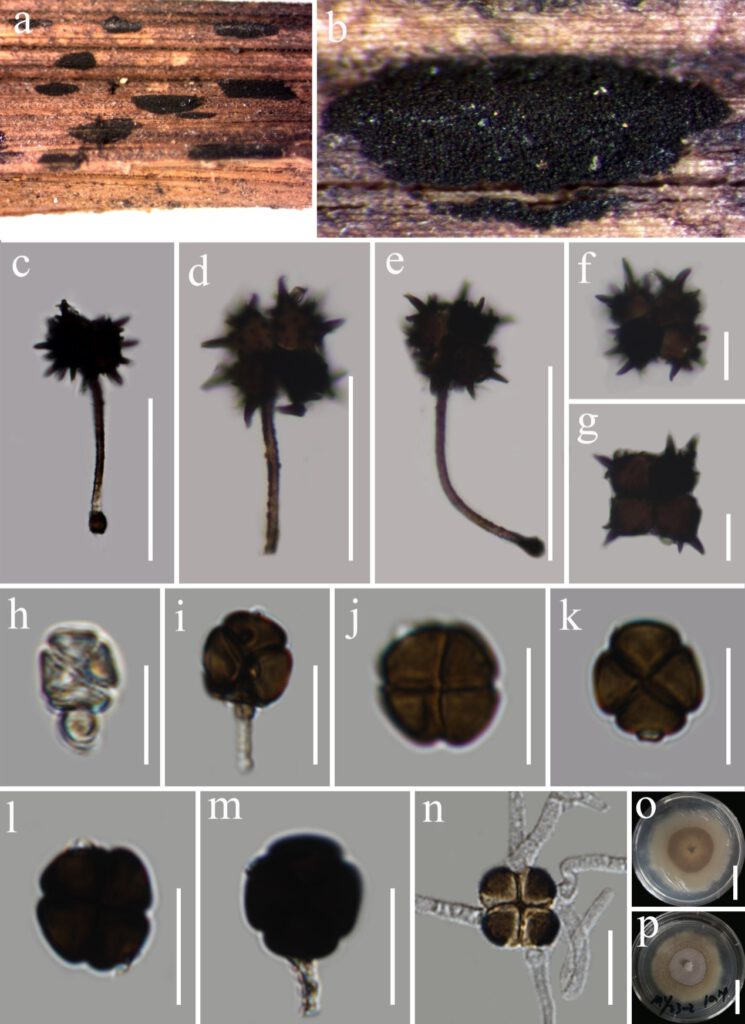Spegazzinia neosundara Thambug. & K.D. Hyde Mycosphere 8(4): 724 (2017). Fig. 9
MycoBank number: MB 553163; Index Fungorum number: IF 553163; Facesoffungi number: FoF 03222;
Saprobic on dead woody twigs Lithocarpus (Fagaceae) Sexual morph: Undetermined. Asexual morph: Hyphomycetous. Sporodochia dark, dry, dense, powdery, 2–3 mm diameter. Conidiophore mother cells 4–5 × 3.5–4.5 μm (x̅ = 5.1 × 4.5 μm, n = 6) dark brown, oval or subspherical. Conidiogenous cells basauxic, ampulate, 5–6 μm high × 4–5 μm wide (x̅ = 5.5 × 4.5 μm; n = 10), subspherical, hyaline to light brown. Conidiophores of α conidia up to 35–50 × 1.5–2.0 μm (x̅ = 40 × 1.9 μm, n = 10), erect or flexuous, unbranched, dark golden brown. Conidiophores of β conidia 4–8 × 1.5–2 μm (x̅ = 5.7 × 1.7 μm, n = 10) short, erect, unbranched, subhyaline or light brown. α conidia 11–17 × 11–17 μm (x̅ = 14.5 × 14.8 μm; n = 30), 4-celled, stellate-shaped, brown to black brown, each cell globose to subglobose with conspicuous spines 1–2 μm wide, deeply constricted at the septa, smooth, flat from th side view. β conida 9–14 × 10–14 μm (x̅ = 11.5 × 11.7 μm; n = 40), subspherical, 4-celled, disc-shaped, initially pale brown, becoming brown to dark brown at maturity, crossed septate, constricted at the septa, smooth to verrucose.
Culture Characters ‒ Colonies on PDA, reaching 70–80 mm diam. at 14 days at room temperature (25–30 ℃), superficial, circular, rough, with sparse mycelia, flat, greyish-white at the center, pale greenish-olivaceous at the margin, surface smooth, moderately dense, margin crenulate; reverse greyish-white at the margin, pale greenish-olivaceous at the center.
Known distribution ‒ Known to inhabit dead leaves of Cortaderia sp. (Poaceae) (Thambugala et al. 2017) and dead woody twigs of Lithocarpus (Thailand).
Material examined ‒ Thailand, Chiang Rai Province, Mae Yao District, on dead woody twigs of Sapindaceae sp., 23 September 2019, G.C. Ren, MY23-2 (KUN-HKAS 122783), living culture, KUMCC 21-0633.
Notes ‒ Spegazzinia neosundara was introduced by Thambugala et al. (2017) based on morphological and phylogenetic analyses. The characters of our new strain of Spegazzinia neosundara (KUMCC 21-0633) are similar to the type strain (MFLUCC 15–0456) in having dark, dense sporodochia, basauxic, ampulate conidiogenous cells, stellate-shaped α conidia, and disc-shaped β conidia. The multi-gene phylogenetic analysis based on combined SSU, LSU, ITS, and tef1–α sequence data showed that our isolate (KUMCC 21-0633) is monophyletic with Spegazzinia neosundara (MFLUCC 15–0456) with strong statistical support (100 % ML, 1.00 PP; Fig. 1). Based on morphological characteristics and phylogenetic analysis, we report KUMCC 21-0633 as a new host record of Spegazzinia neosundara from the decaying wood of Lithocarpus in Thailand.

Figure 9 ‒ Spegazzinia neosundara (KUN-HKAS 122783) a, b Fungal colonies on host surface. c–e Conidiophore of α conidia and α conidia (conidiogenous mother cell in c and e). f, g α conidia. h–m β conidia. n Germinated conidium. o, p Culture characters on PDA. Scale bars: c–e = 40 μm, f–n = 10 μm, o, p = 30 mm.
